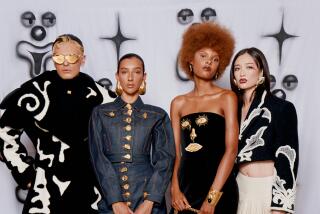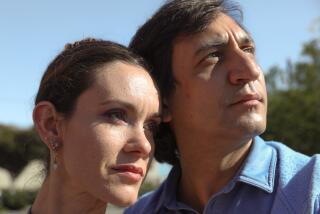San Francisco Ballet at the Orange County Performing Arts Center
San Francisco Ballet, this nation’s oldest classical dance company, is 75 years young -- to underscore the compliment.
When you’ve lasted that long and are kicking up your heels as well as these dancers do, it’s worth a celebration. Artistic director Helgi Tomasson and his international cast have thrown a few special events this year, devoting themselves to some masters, such as Jerome Robbins, and some historic ballets, such as “Filling Station,” by former company director and star Lew Christensen. Tomasson also impressively commissioned 10 pieces for the occasion.
Best of all for local audiences, San Francisco Ballet is back through Sunday at the Orange County Performing Arts Center, its third stop on a national tour. And Tomasson and center officials bravely scheduled two programs of shorter ballets featuring five Southland premieres.
It takes guts to leave the story ballets at home -- sad but true -- and even more so during troubled times. If you doubted that truth, all you had to do was look around at the empty seats on opening night Tuesday.
Certainly, a good part of San Francisco Ballet’s success is owed to a continuous supply of new ballets, from its early years onward. Tomasson, in his 24th season as artistic director, continues that mission. In addition, he has polished the dancing, creating an unmannered San Francisco style of great clarity.
That’s not to say that every ballet Tuesday was a 10, nor was every interpretation, as it turned out.
In “Fusion,” resident choreographer Yuri Possokhov sought to represent a transformation in his own life -- from full-time dancer to choreographer -- through contrasting groups of dancers and theatrical imagery. The score shifted from jazz by Graham Fitkin to melodies by popular Indian film composer Rahul Dev Burman.
The cast too was divided. Four barefoot male dancers, wearing white belted tunics and loose pants, were at odds with four couples in contemporary unitards and traditional footwear. (Sandra Woodall did the stylish costumes.) The ballet opened with the white “dervish” group seated onstage and ended with the unitard men sitting likewise, but at the opposite side of the stage.
It was possible to interpret this progression as personal transformation, though Possokhov was perhaps not being so literal. Whatever his intended meaning, the work itself was more skin deep. Possokhov decorated the dancers with arms in a stiff L-shape and with back-bending leaps. He paid lip service to the elements of jazz, with different body isolations for each group.
In the first and third sections, the choreographer set the stage awhirl with unison spinning and jumping, the kind of nonstop, nervous allegro that has become de rigueur these days. Music and movement did not compete, but neither deeply reflected the other.
A striking middle pas de deux for Yuan Yuan Tan and Damian Smith, however, allowed us to stop, breath and enjoy. Tan at first attempted to exit the stage through a cordon of dervish men but kept being thrust back onstage. Discordant piano melodies reminiscent of Thelonious Monk provided a moving backdrop for a woeful but elegant duet for these two great stars.
Christopher Wheeldon’s ballet, “Within the Golden Hour,” bore superficial movement similarities to Possokhov’s piece, calling into question the wisdom of programming them together. But after a confusing and jumbled first section, “Within the Golden Hour” became a musical adventure, and it was the highlight of the evening.
More than any of his contemporaries, Wheeldon, 35, has a gift for marking his ballets with kinetic signposts that capture a feeling deep within his chosen score. For this ballet, he worked with string pieces by Italian composers Ezio Bosso and Antonio Vivaldi. A repeated, late-entry lift in the ballet’s jumbled introductory section pulled this viewer out of the doldrums as ballerinas snapped their legs and arms simultaneously in a kind of mini-explosion.
Four subsequent duets took us on a stimulating journey via different signature phrases. The tall, versatile Smith partnered Katita Waldo in a jaunty pizzicato waltz. Petite Maria Kochetkova melted effortlessly into the firm grip of Joan Boada; here was an astonishingly seamless adagio and a flawless duo who made it hard to tell which of them was instigating the first move. Martyn Garside and Garen Scribner played a frisky game of copycat, while Sarah Van Patten and Pierre-Francois Vilanoba stretched time through lush, ever-lengthening poses.
After all this luxurious invention, expectations were high for George Balanchine’s “The Four Temperaments,” the 1946 ballet to Paul Hindemith’s magical score, both of which broke the ceiling for today’s dance-makers. The ballet has a 34-year history in San Francisco; Lew Christensen was in the original cast.
Alas, it received a mostly bloodless interpretation -- clear but cold. Taras Domitro, a lithe, flexible, boyish principal, provided the exception in the Melancholic variation. Even he, though, seemed distracted by rather than freed through the steps. It was an unexpected switcheroo, given how liberated the dancers looked the rest of the evening.
Conductor Martin West led an outstanding pickup ensemble through the program’s diverse musical selections. It was a great concert, that’s for sure, giving credence to Balanchine’s remark that when dancing fails to hit its mark, you can always close your eyes and listen.
Bleiberg is a freelance writer.
More to Read
The biggest entertainment stories
Get our big stories about Hollywood, film, television, music, arts, culture and more right in your inbox as soon as they publish.
You may occasionally receive promotional content from the Los Angeles Times.






